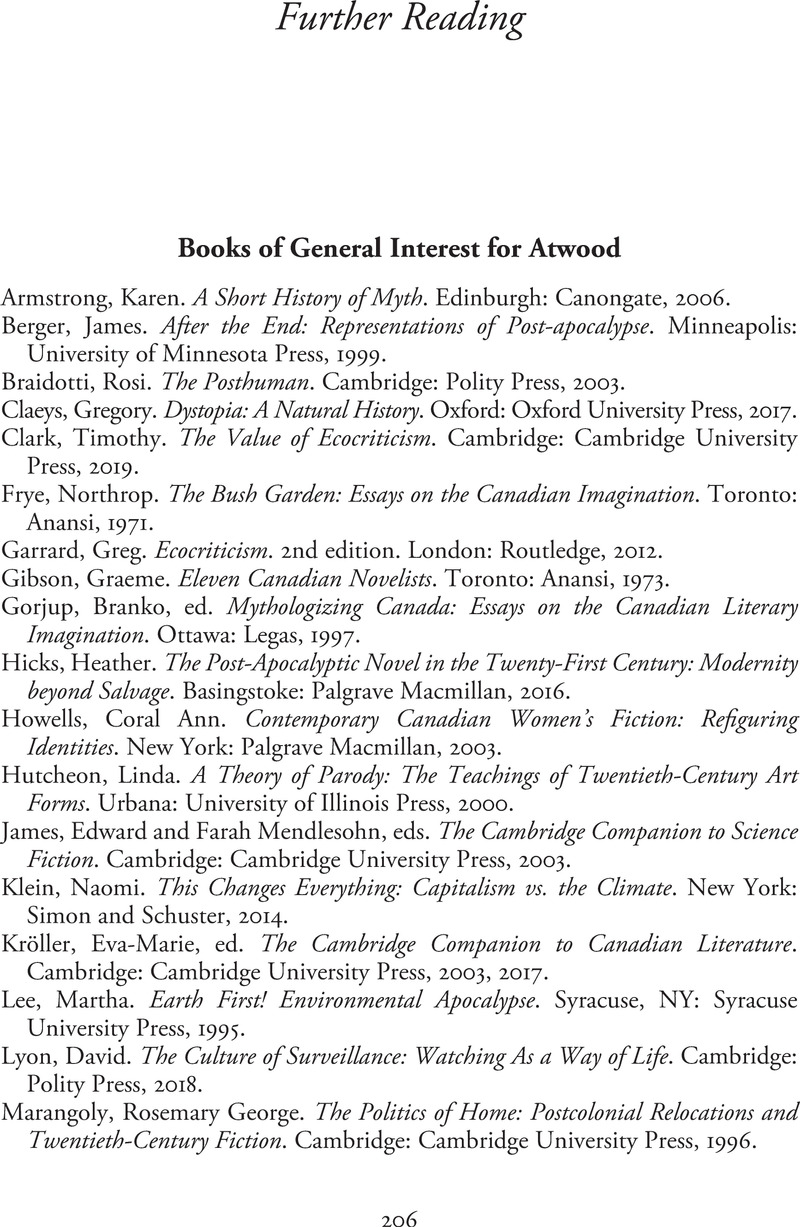Book contents
- The Cambridge Companion to Margaret Atwood
- The Cambridge Companion to Margaret Atwood
- Copyright page
- Dedication
- Contents
- Notes on Contributors
- Preface
- Acknowledgments
- Note on Editions Used
- Abbreviations
- Margaret Atwood Chronology
- Introduction
- Chapter 1 Margaret Atwood in Her Canadian Context
- Chapter 2 Margaret Atwood on Questions of Power
- Chapter 3 Home and Nation in Margaret Atwood’s Later Fiction
- Chapter 4 Margaret Atwood’s Female Bodies
- Chapter 5 Margaret Atwood and Environmentalism
- Chapter 6 Margaret Atwood and History
- Chapter 7 Margaret Atwood’s Revisions of Classic Texts
- Chapter 8 Margaret Atwood’s Humor
- Chapter 9 Margaret Atwood’s Poetry and Poetics
- Chapter 10 Margaret Atwood’s Later Short Fiction
- Chapter 11 Margaret Atwood’s Recent Dystopias
- Chapter 12 The Hulu and MGM Television Adaptation of The Handmaid’s Tale
- Further Reading
- Index
- Cambridge Companions To …
- References
Further Reading
Published online by Cambridge University Press: 19 March 2021
- The Cambridge Companion to Margaret Atwood
- The Cambridge Companion to Margaret Atwood
- Copyright page
- Dedication
- Contents
- Notes on Contributors
- Preface
- Acknowledgments
- Note on Editions Used
- Abbreviations
- Margaret Atwood Chronology
- Introduction
- Chapter 1 Margaret Atwood in Her Canadian Context
- Chapter 2 Margaret Atwood on Questions of Power
- Chapter 3 Home and Nation in Margaret Atwood’s Later Fiction
- Chapter 4 Margaret Atwood’s Female Bodies
- Chapter 5 Margaret Atwood and Environmentalism
- Chapter 6 Margaret Atwood and History
- Chapter 7 Margaret Atwood’s Revisions of Classic Texts
- Chapter 8 Margaret Atwood’s Humor
- Chapter 9 Margaret Atwood’s Poetry and Poetics
- Chapter 10 Margaret Atwood’s Later Short Fiction
- Chapter 11 Margaret Atwood’s Recent Dystopias
- Chapter 12 The Hulu and MGM Television Adaptation of The Handmaid’s Tale
- Further Reading
- Index
- Cambridge Companions To …
- References
Summary

- Type
- Chapter
- Information
- The Cambridge Companion to Margaret Atwood , pp. 206 - 212Publisher: Cambridge University PressPrint publication year: 2021

